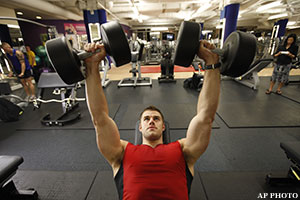
If you don't watch your figure, the saying goes, who will? Kind of a harsh statement, for sure, but that's now a corporate policy at Equinox Fitness.
Personal trainers at Equinox will be wearing form-fitting shirts to help show off their physiques. In June, Equinox sent trainers an email announcing the change, giving them time to lose weight -- lest a compression-type shirt would be less than flattering.
Ouch.
From a purely superficial perspective, it makes sense. To some, a trainer who looks great in a tight shirt must really know a lot about fitness, right? And besides, for lots of us, our appearance is the main reason we hit the gym.
And yes, if you work in the fitness industry, you shouldn't be carrying a bunch of extra weight around the middle. We all know the irony of an overweight doctor or nurse telling us to lose weight, and the same goes for a personal trainer.
However, selecting a trainer is a process that should be much more thorough than checking if he or she has a six-pack.
When car shopping, you don't automatically buy the best looking car in your price range without any regard for performance and reliability, right? The same should go for your personal trainer.
You're selecting someone that will ideally help you look and feel better. Just because someone won the genetic lottery doesn't mean they're automatically the smartest person when it comes to training.
"Experience is what yields perspective," Eric Cressey, a owner of Cressey Performance, says. "When you look at a fit personal trainer, it can either come from being genetically blessed, or from actually having to work for it. I'd estimate that it's about a 50/50 split, based on what I've seen at industry events.
"Additionally, looking fit is just one piece of the puzzle. I've seen trainers who looked fit, but were complete wrecks in terms of musculoskeletal health, blood work, and psychological health."

So what's really important in finding a trainer?
1. Ask for biographies of all of the personal trainers at your gym. Yes, a lot of biographies are needlessly pumped up, and more certifications aren't necessarily better. However, you can get an idea of which trainers would be compatible with you and your interests, and you can Yahoo! search what ACE, NSCA, NASM and other acronyms mean.
2. Pay attention to what trainers are doing with other clients. Don't stare, of course, but keep an eye at the form that clients are using and the exercises that are being prescribed. Does a trainer have his or her clients do quarter-squats and crunches? Bad sign. Move on.
3. Before you commit to buying a training package, talk to your trainer. And after you put down the money, an assessment should always be first. These are your goals and your body. The plan should be adapted to you. You shouldn't be adapted to the plan. "In the initial orientation, make sure you feel comfortable with the personal trainer," says Jessica Velazquez, a Kansas City-based personal trainer. "Initial orientations and assessments between the health-seeker and personal trainer can be intimidating. Nobody likes to get picked and poked and told in several different ways how they are out of shape and fat. Make this an opportunity to assess your trainer as much as they assess you."
4. Question, question, question. No, I'm not saying you need to buy some textbooks and study yourself, but if you're unsure of what muscle the exercise you're about to do is supposed to work, ask. Are you wondering why you're feeling the soreness in a specific area? Ask. Every great trainer should have a specific reason for every person and every exercise. If you find a lot of hesitation or some shoulder shrugs, find another trainer. This is one thing that isn't like car shopping. You should never be locked into a long-term lease.




